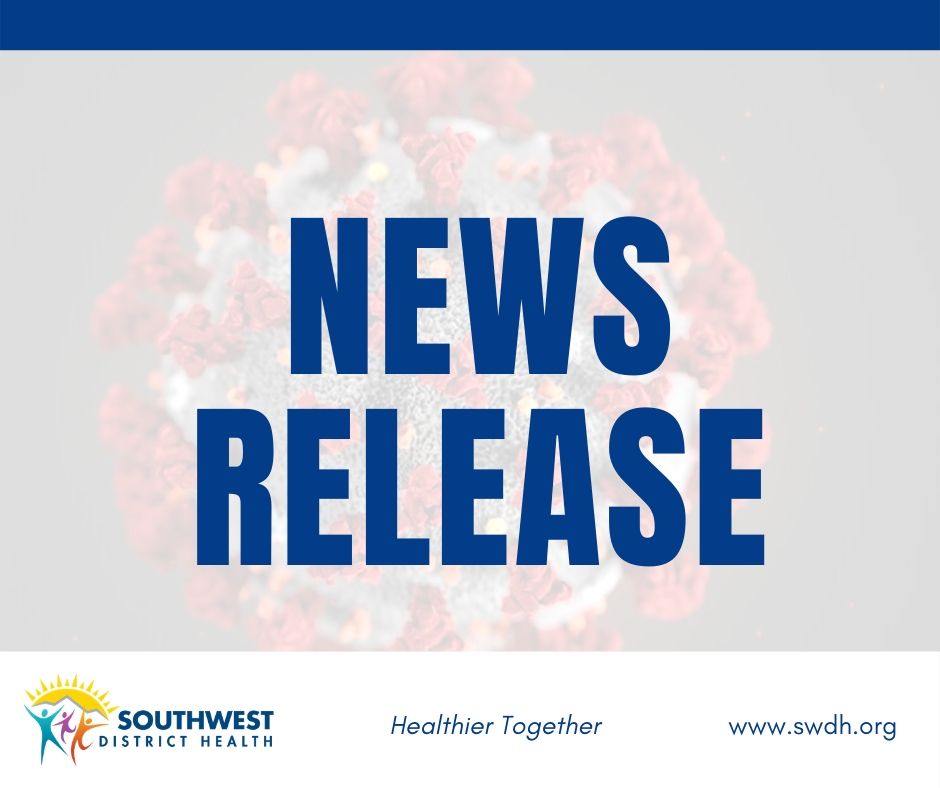FOR IMMEDIATE RELEASE
Southwest District Health notes increase in RSV cases;
encourages RSV and flu illness prevention and common sense
Southwest District Health (SWDH) officials have noted an increase in the number of RSV cases in our area and encourage individuals to be aware of the signs and symptoms of RSV and other respiratory illnesses and to take preventive measures to keep themselves and their families healthy during the upcoming holiday season. Some hospitals and healthcare organizations around the nation report maxed out hospital capacity and overrun emergency departments due to RSV. Now is the time to take precautions and know how you can prevent becoming ill and how to protect others in your family if you do become ill.
“Case trends for RSV activity in our area will change quickly as cases usually peak between December and February,” said Josh Campbell, SWDH Family and Clinic Services Division Administrator. “We want everyone to use common sense to know when to go and when to stay home this season, especially as we enter the holidays.”
Some of the ways you can help prevent becoming ill with RSV and flu include:
- Cover coughs and sneezes
- Wash hands frequently and correctly (with soap and water for 20 seconds)
- Avoid sharing cups and eating utensils with others
- Avoid touching your face with unwashed hands
- Avoid close contact with sick people
- Stay home when sick
- Consider wearing a mask if you need to be in public
- Clean and disinfect surfaces such as doorknobs and countertops frequently
- Get the flu vaccine – Everyone 6 months and older are eligible for the flu vaccine
- Practice healthy habits such as eating whole nutritious foods, exercising, and socializing
RSV is a common virus that usually causes mild, cold-like symptoms in adults. Most children can be treated at home and will recover in a week or two but some individuals may be at higher risk for severe illness that could require hospitalization. Infants less than six months old, those born prematurely, children six months to 2 years of age with chronic lung or heart disease, or immunocompromising conditions, and older individuals especially over the age of 65, may be at risk of severe illness from RSV. Those with higher risk of severe illness should avoid contact with sick people or settings, such as childcare centers, where RSV may easily spread. Individuals having difficulty breathing, trouble eating or drinking due to rapid breathing, or those with worsening symptoms, should contact their healthcare provider.
RSV can be spread when an infected person coughs or sneezes sending virus containing droplets into the air, where they can infect a person who inhales the droplets. Direct contact with the virus can occur, for example, by kissing the face of a child with RSV. Indirect contact can occur if the virus lands on a surface, such as a doorknob or table, that is then touched by other people who touch their eyes, mouth, or nose before washing their hands. Most commonly, people with RSV are contagious for three to eight days and may be contagious 1 or 2 days before they show signs of illness. Being infected with RSV once does not make you immune and reinfection does occur.
Though there is no vaccine for RSV, flu vaccinations are available at SWDH. Call (208) 455-5300 to schedule your appointment. Join SWDH in becoming Healthier Together. Check out the programs SWDH offers to help your family be their healthiest including Women, Infants, and Children (WIC) at https://swdh.id.gov/healthy-living/about-contact-info/. Also, you can stay up to date with healthy living updates from SWDH when you subscribe to our every other month “Healthier Together” newsletter. Click HERE to Subscribe!
For more information, visit the below links:
- https://www.cdc.gov/rsv/about/prevention.html
- https://healthandwelfare.idaho.gov/health-wellness/diseases-conditions/respiratory-syncytial-virus
- To view Idaho RSV data:https://www.gethealthy.dhw.idaho.gov/resp-synct.
- To learn more about RSV, please visit: https://www.cdc.gov/rsv/index.html
# # #
Media Contacts
Southwest District Health:
Ashley Anderson Ashley.Anderson@phd3.idaho.gov
Katrina Williams Katrina.Williams@phd3.idaho.gov
